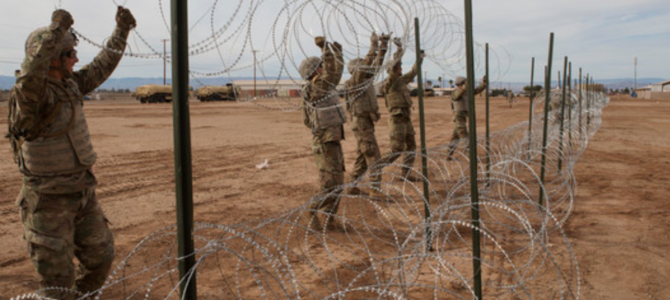
Often lost in the discussion of hundreds of thousands of Central Americans pouring over the southern border is that migrants from Muslim-majority countries where Islamist terrorist groups operate arrive among them almost every day. The corporate media hates talking about this. But most border-crossers show up without any identification and little vetting, giving rise to U.S. national security efforts to stifle this human traffic for fear of terrorist infiltration, a threat about which I have written extensively.
Every so often, smugglers of migrants from countries of national security concern — known in government parlance as “special interest aliens” — are caught and brought to American justice. Such was the case last week, when a federal judge in a Del Rio, Texas, courtroom empty of news reporters sentenced a Mexico-based Jordanian smuggler named Moayad Heider Mohammad Aldairi to three years in the federal penitentiary on a guilty plea.
His case is interesting because it briefly illuminates a fascinating kind of American counterterrorism-immigration operation reporters must do acrobatic yoga to avoid covering. The Aldairi case also demonstrates why this exotic sort of human smuggling presents a national security threat to the homeland and has spawned James Bondian foreign efforts to take other Aldairis offline.
Who Were the Yemenis Aldairi Smuggled?
Before a complex, multinational Immigration and Customs Enforcement-Homeland Security Investigations dragnet snagged Aldairi last year at John F. Kennedy International Airport in New York, he ran a business that in 2017 smuggled over the Mexico-Texas border at least six Yemenis for whom he was charged. He likely brought in many more than that.
That at least six unknown and unvetted Yemenis were smuggled over the Texas border from Mexico should be a recognizable problem on its face, although it’s often denied as perfectly innocent immigration that nativist right-wingers baselessly play up. Yemen is embroiled in a civil war in which one major armed faction, which controlled sizable chunks of territory, is al-Qaeda in the Arabian Peninsula.
Throughout the 2018 prosecution of Aldairi, U.S. prosecutors wouldn’t say whether any of the Yemenis that Aldairi smuggled through Latin America were part of al-Qaeda or their victims. But San Antonio Express-News reporter Guillermo Contreras reported this spring that “law enforcement sources” told the newspaper “some of the six Yemenis” that successfully crossed into Texas were on the U.S. terror watch list. Federal law enforcement sources with direct knowledge of the investigation have told me the same.
Where they are today and how serious a threat the Yemenis posed is only narrowly known, although my sources told me that at least three of the six remain inside the United States. I’m guessing those would be cooperating witnesses against Aldairi and that one or more of the other three were the terror suspects.
Special Interest Alien Smugglers Are Sophisticated
They would hardly be the first known or suspected terrorists to have reached the U.S. southern border. It’s a fairly regular occurrence, and that’s why special interest alien smuggling worries homeland security officials on a nonpartisan basis, as evidenced by President Barack Obama’s most senior appointees taking strong action to shut it down in 2016. Watch-listed suspects and those not watch-listed arrive annually among at least several thousand special interest aliens (SIAs) who show up every year at the southern border.
Aldairi is typical of SIA smugglers in that they are pretty sophisticated internationalists not easily replaceable when taken offline. He is a Jordanian national with dual Mexican citizenship, dual residencies, and multiple languages. In addition to Arabic, Aldairi spoke Russian, Spanish, and English.
Prior court prosecutions of SIA smugglers show many hold dual citizenships, are multilingual, and have managed to corrupt government bureaucrats in key locations. This combination of skillsets is necessary to run intercontinental smuggling businesses that require air travel and crossing potentially dozens of borders over vast distances and time frames. So when American authorities take out one of these guys, not too many replacements are in line to take over.
Aldairi was fairly clever in ways we should expect. For example, he provided hard hats and reflective yellow vests to his Yemeni clients so they would look like construction workers who belonged on the Texas side of the Rio Grande near Eagle Pass.
U.S. Homeland Security Agencies Are Targeting the Threat
U.S. homeland security agencies have so seriously regarded illicit migration to U.S. land borders from Muslim-majority countries that after 9/11, the U.S. government passed legislation that required smuggling interdiction programs to take out people like Aldairi. One of the main efforts to reduce the threat was the deployment of ICE-Homeland Security Investigations (ICE-HSI) all over Latin America, backed by the intelligence efforts of other outfits, such as the U.S. Southern Command. That’s who got Aldairi.
The last year has been particularly good for ICE-HSI doing this work, although you wouldn’t know it from corporate reporting. The most recent damage was doled out when Brazilian federal police in Sao Paulo rolled up three notorious smugglers: a Somali, an Algerian, and an Iranian based in Brazil.
They were responsible for transporting immigrants from countries of national security concern to the U.S. southern border for years, including, according to Brazilian media, “two Somalis arrested by the US police over suspected terrorism.” Hence the homeland security importance of targeting special interest alien smuggling networks such as these. Some others include:
- Two Mexico-based Bangladeshi smugglers who worked closely with co-conspirators in Brazil and beyond to smuggle in large numbers of Bangladeshis, one of the most prevalent nationalities being moved over the U.S. border. One smuggler worked at the Guatemala border, while the other was based in northern Mexico. On Thursday, the Department of Justice announced the arrest of a third co-conspirator in Brazil who fed migrants to a conveyor belt that constantly moved South Asians through Central America and Mexico.
- A former Afghan interpreter for the U.S. Army, New Jersey resident Mujeeb Rahman Saify, was charged with crimes related to him facilitating the smuggling of at least two other Afghans to the Texas border, one of whom chose to enter this way because he had been terminated from Army service “for being a security risk based on his association with a foreign intelligence service.” Both of the smuggled Afghans actually made it over the Texas border.
- A Brazil-based Somali smuggler, Mohamed Abdi Siyad, a.k.a. “Hassan,” was accused in a criminal complaint of transporting many dozens of Somalis and other Horn of Africa migrants — Islamic extremists potentially among them — from Africa through Latin America and on to both the California and Texas borders. Hassan reportedly is not in U.S. custody yet, but because of the ICE-HSI pressure, he is out of service in Brazil and the subject of an extradition process to retrieve him from Canada (probably a long story there).
- A notorious Costa Rican smuggler known as “Mama Africa,” who I’m told worked with the Brazilian smugglers and Hassan, was finally arrested after years of moving migrants from Muslim-majority nations as an important link in the smuggling chain. She and her family and associates moved migrants regarded as higher risk to Honduras by boat, then to Guatemala and Mexico.
The Aldairi Case Is a Win for U.S. Counterterrorism
It’s unclear why U.S. prosecutors threaded the needle around Aldairi’s smuggling of watch-listed Yemenis into Texas; U.S. Attorney John Bash of the Western District of Texas declined an interview request. They could have sought a more serious material support charge or threw a terrorism enhancement request to the judge. Soon Aldairi will be a free man, probably back in Mexico with his wife and son in Monterrey in a couple of years with time served.
But still, this is a win for our side in counterterrorism, and it’s not just me saying why.
In a prepared DOJ press release, Bash showed he does understand what this was about. “This case vividly illustrates how border security is a key component of national security,” he said in the release. “We simply must know the identities of every individual crossing our southern border, particularly those who are nationals of countries where terrorist organizations operate freely.”









